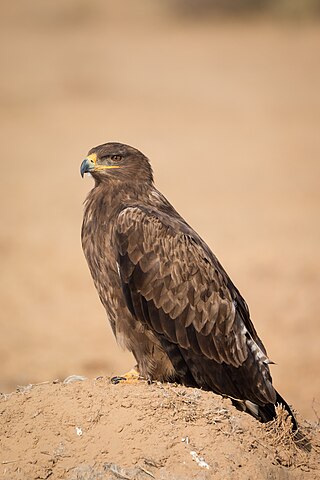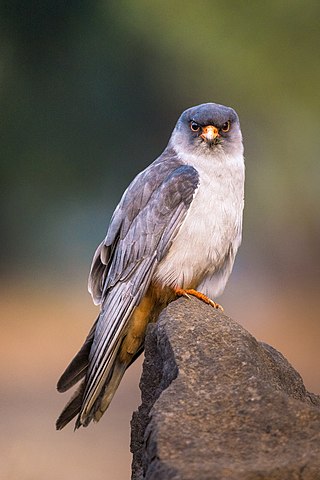
Falcons are birds of prey in the genus Falco, which includes about 40 species. Falcons are widely distributed on all continents of the world except Antarctica, though closely related raptors did occur there in the Eocene.

The eastern imperial eagle is a large bird of prey that breeds in southeastern Europe and extensively through West and Central Asia. Most populations are migratory and winter in northeastern Africa, the Middle East and South and East Asia. Like all eagles, the eastern imperial eagle is a member of the family Accipitridae. Furthermore, its feathered legs mark it as a member of the subfamily Aquilinae. It is a large, dark-colored eagle, with a resemblance to other members of the genus Aquila but it is usually the darkest species in its range. This is an opportunistic predator that mostly selects smallish mammals as prey but also a fairly large proportion of birds, reptile and other prey types, including carrion. Compared to other Aquila eagles, it has a strong preference for the interface of tall woods with plains and other open, relatively flat habitats, including the wooded mosaics of the steppe. Normally, nests are located in large, mature trees and the parents raise around one or two fledglings. The global population is small and declining due to persecution, loss of habitat and prey. It has therefore been IUCN Red Listed as Vulnerable since 1994.

The peregrine falcon, also known simply as the peregrine, and historically as the duck hawk in North America, is a cosmopolitan bird of prey (raptor) in the family Falconidae. A large, crow-sized falcon, it has a blue-grey back, barred white underparts, and a black head. The peregrine is renowned for its speed. It can reach over 320 km/h (200 mph) during its characteristic hunting stoop, making it the fastest member of the animal kingdom. According to a National Geographic TV program, the highest measured speed of a peregrine falcon is 389 km/h (242 mph). As is typical for bird-eating (avivore) raptors, peregrine falcons are sexually dimorphic, with females being considerably larger than males.

Falconry is the hunting of wild animals in their natural state and habitat by means of a trained bird of prey. Small animals are hunted; squirrels and rabbits often fall prey to these birds. Two traditional terms are used to describe a person involved in falconry: a "falconer" flies a falcon; an "austringer" keeps Goshawks And uses accipiters for hunting. or an eagle. In modern falconry, the red-tailed hawk, Harris's hawk, and the peregrine falcon are some of the more commonly used birds of prey. The practice of hunting with a conditioned falconry bird is also called "hawking" or "gamehawking", although the words hawking and hawker have become used so much to refer to petty traveling traders, that the terms "falconer" and "falconry" now apply to most use of trained birds of prey to catch game. However, any contemporary practitioners still use these words in their original meaning.

The long-legged buzzard is a bird of prey found widely in several parts of Eurasia and in North Africa. This species ranges from Southeastern Europe down to East Africa to the northern part of the Indian subcontinent. The long-legged buzzard is a member of the genus Buteo, being one of the larger species therein. Despite being relatively powerful, it is considered a rather sluggish raptor overall. Like most buzzards, it prefers small mammals such as rodents, including gerbils, ground squirrels, voles and rats, also taking reptiles, birds and insects as well as carrion. Adaptable to a variety of habitats, long-legged buzzards may nest on a variety of surfaces, including rocks, cliffs and trees. it is a typical buzzard in its reproductive biology. The long-legged buzzard is widely distributed and appears to be quite stable in population. Therefore, it is considered as Least Concern by the IUCN.

The steppe eagle is a large bird of prey. Like all eagles, it belongs to the family Accipitridae. The steppe eagle's well-feathered legs illustrate it to be a member of the subfamily Aquilinae, also known as the "booted eagles". This species was once considered to be closely related to the sedentary tawny eagle and the two forms have previously been treated as conspecific. They were split based on pronounced differences in morphology and anatomy; two molecular studies, each based on a very small number of genes, indicate that the species are distinct but disagree over how closely related they are.

The lanner falcon is a medium-sized bird of prey that breeds in Africa, southeast Europe and just into Asia. It prefers open habitat and is mainly resident, but some birds disperse more widely after the breeding season. A large falcon, it preys on birds and bats. Most likely either the lanner or peregrine falcon was the sacred species of falcon to the ancient Egyptians, and some ancient Egyptian deities, like Ra and Horus, were often represented as a man with the head of a lanner falcon.

The Barbary falcon is a medium-sized falcon about the size of a crow. This bird of prey is mainly resident. It ranges from the Canary Islands eastwards across some parts of North Africa, the Middle East and Central Asia.

The saker falcon is a large falcon species. It breeds from Central Europe eastwards across the Palearctic to Manchuria. It is a partial migrant, which means that some part of the population is migratory, some part is not. In Europe, for example, a part of the juveniles are migrating, while adults are mostly resident. The European and West Asian migratory sakers spend the winter in the Sahel region. On migration, they cross the Middle East, the Arabian peninsula, and Pakistan, where they are exposed to illegal trapping. The migratory birds to the east from Altai Mountains spend the winter in the Qinghai-Tibet Plateau.

The prairie falcon is a medium-large sized falcon of western North America. It is about the size of a peregrine falcon or a crow, with an average length of 40 cm (16 in), wingspan of approximately 1 meter (40 in), and average weight of 720 g (1.6 lb). As in all falcons, females are noticeably bigger than males. Though a separate species from the peregrine, the prairie falcon is basically an arid environment divergence of the early peregrine falcon lineage, able to subsist on less food than the peregrine, and generally lighter in weight than a peregrine of similar wing span. Having evolved in a harsh desert environment with low prey density, the prairie falcon has developed into an aggressive and opportunistic hunter of a wide range of both mammal and bird prey. It will regularly take prey from the size of sparrows to approximately its own weight, and occasionally much larger. It is the only larger falcon native only to North America. It is resident from southern Canada, through western United States, and into northern Mexico. The prairie falcon is popular as a falconry bird, where with proper training it is regarded as being as effective as the more well known peregrine falcon.

The Amur falcon is a small raptor of the falcon family. It breeds in south-eastern Siberia and Northern China before migrating in large flocks across India and over the Arabian Sea to winter in Southern and East African coasts.

The black falcon is a medium-large falcon that is endemic to Australia. It can be found in all mainland states and territories and yet is regarded as Australia's most under-studied falcon.

The hierofalcons are four closely related species of falcon which make up the subgenus Hierofalco:

Hunting with eagles is a traditional form of falconry found throughout the Eurasian Steppe, practiced by ancient Khitan and Turkic peoples. Today it is practiced by Kazakhs and the Kyrgyz in contemporary Kazakhstan and Kyrgyzstan, as well as diasporas in Bayan-Ölgii Provinces Bayan-Ölgii, Mongolia, and Xinjiang, China. Though these people are most famous for hunting with golden eagles, they have been known to train northern goshawks, peregrine falcons, saker falcons, and more.

The Altai snowcock is a species of bird in the family Phasianidae. It is found in western Mongolia and adjacent areas of China, Kazakhstan and Russia. Its natural habitat is boreal forests.

The upland buzzard is a species of bird of prey in the family Accipitridae. The largest species of the Buteo genus, this buzzard lives in mountainous grassy and rocky areas in areas of Central Asia, northern South Asia and East Asia from Kazakhstan to Korea. The upland buzzard is migratory but typically covers a short distance apparently to avoid snow cover that may hamper prey capture. This species primarily subsists on small mammals but does not shun alternate prey from small to large birds and insects. This little known raptor has a large range, and though generally uncommon, it is not thought to be rare or declining as a species. As a result it is classified as least concern by the IUCN.

The Mongolian lark is a species of lark in the family Alaudidae found from southern Russia and Mongolia to central China.

The gyrfalcon, the largest of the falcon species, is a bird of prey. The abbreviation gyr is also used. It breeds on Arctic coasts and tundra, and the islands of northern North America and the Eurosiberian region. It is mainly a resident there also, but some gyrfalcons disperse more widely after the breeding season, or in winter. Individual vagrancy can take birds for long distances. Its plumage varies with location, with birds being coloured from all-white to dark brown. These colour variations are called morphs. Like other falcons, it shows sexual dimorphism, with the female much larger than the male. For centuries, the gyrfalcon has been valued as a hunting bird. Typical prey includes the ptarmigan and waterfowl, which it may take in flight; it also takes fish and mammals.

Dayan Lake is a lake located the district of Sagsai, in the Bayan-Ölgii Province of western Mongolia. It is recognized by BirdLife International as an Important Bird Area since 2009. It is located in the Altai Tavan Bogd National Park.


















